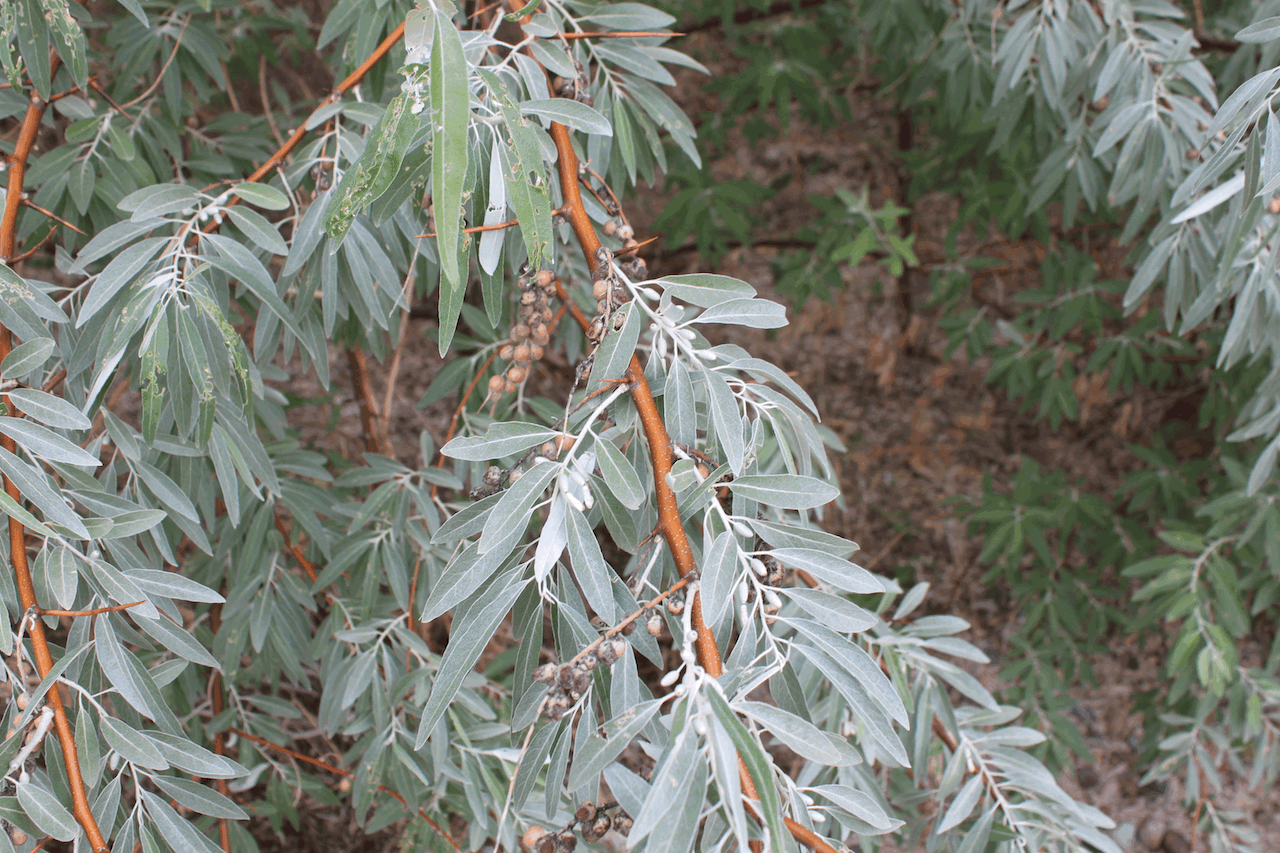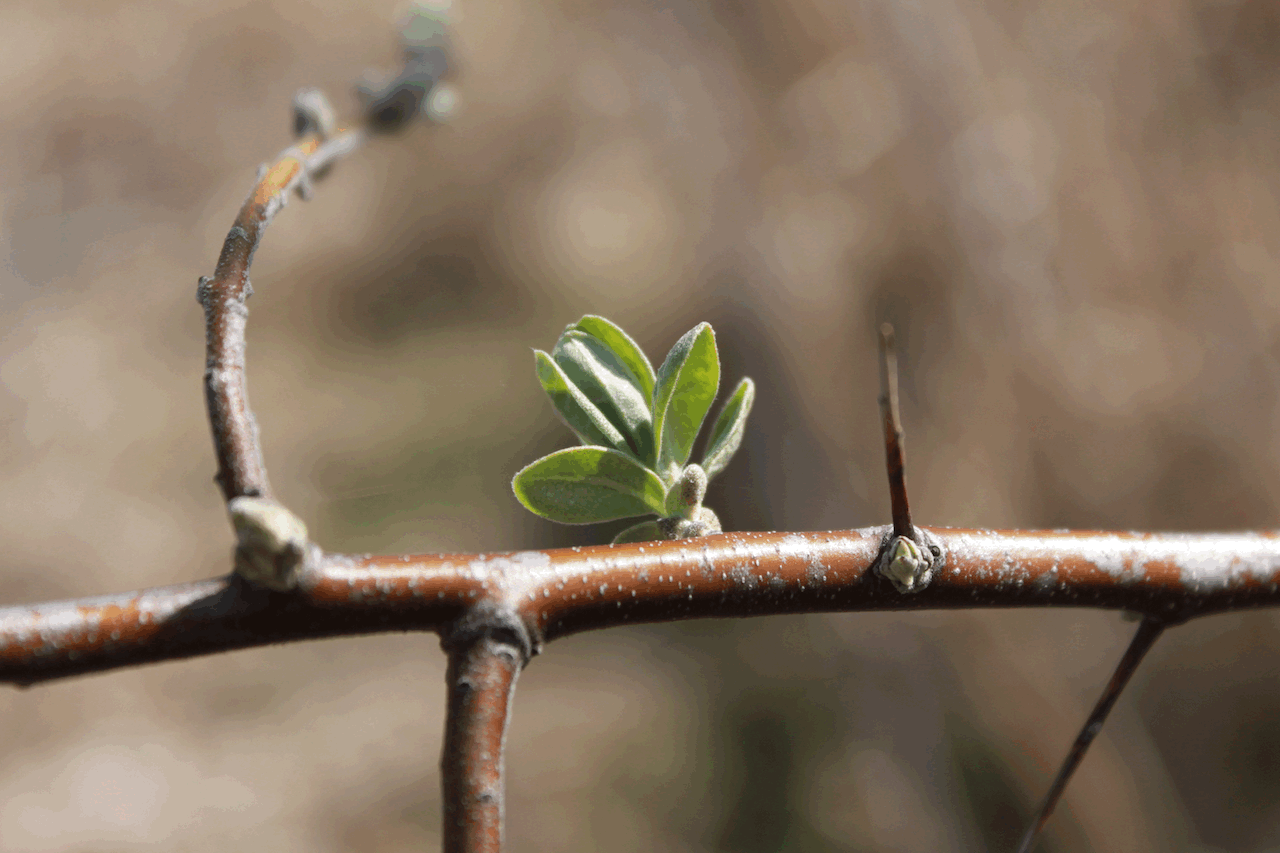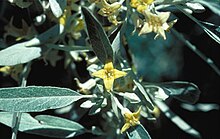
 |
| light green/ silvery leaves |
 |
| yellowish olive-shaped fruit |
 |
| thorns |
 |
| yellow 4-lobed flowers |
BEFORE/AFTER THE INVASION OF RUSSIAN OLIVE

Escalante River just above the ‘Twin Canyons’ between Harris Wash and Choprock
(left\before) April 30, 1991 — No Russian Olive present. Photo: Bill Wolverton
(right\after) April 28, 2010 — 19 years later overrun with Russian Olive. Photo: Bill Wolverton
 Wilderness Volunteers has been actively working to restore southern Utah's magnificent Escalante River corridor since 1998 by fielding multiple Russian Olive removal projects each year. We've coordinated over 58 week-long volunteer service projects over the last 20 years in cooperation with the Glen Canyon National Recreation Area (downstream), Grand Staircase-Escalante National Monument (upstream), the Grand Staircase Escalante Partners, and the Escalante River Watershed Partnership (ERWP).
Wilderness Volunteers has been actively working to restore southern Utah's magnificent Escalante River corridor since 1998 by fielding multiple Russian Olive removal projects each year. We've coordinated over 58 week-long volunteer service projects over the last 20 years in cooperation with the Glen Canyon National Recreation Area (downstream), Grand Staircase-Escalante National Monument (upstream), the Grand Staircase Escalante Partners, and the Escalante River Watershed Partnership (ERWP).The Escalante River runs approximately 90 miles from where the river forms at the merging of the Upper Valley and Birch Creeks to the southeast where it flows into Lake Powell. Volunteers have hiked countless miles into the far reaches of the Escalante to remove Russian Olive. They've used saws, loppers and other small hand tools to cut small RO trees and treated the stumps with herbicide to finish the job. Larger trees were trimmed back, girdled (the bark is removed from the entire circumference of the trunk), and herbicide applied to the cut. Larger RO are often girdled and left standing to minimize the amount of debris on the ground. These trees die and and eventually fall down and are washed out with natural flood activity.




 |
 |
| Just across the river from Choprock Canyon (left\before) August 28, 2009 — Photo: Bill Wolverton (right\after) May 5, 2010 — Photo: Bill Wolverton |
 |
| 0.25 miles above Choprock Canyon (left\before) August 29, 2009 — Photo: Bill Wolverton (right\after) October 16, 2010 — Photo: Bill Wolverton |
As of late 2017, over 84 miles of the 90 mile river corridor had been cleared from the reservoir up and the prediction is that all 90 miles will have been treated by the end of 2018. This isn't the end of our Russian Olive removal efforts in the Escalante (as some areas will need retreatment) but it is an incredible milestone for a massive restoration undertaking that many didn't think was feasible when removal effort first began.
Thank you to all of the dedicated volunteers, public land agency staff, and tireless weed warriors who have made this possible.
"Off in the east an isolated storm is boiling over the desert, a mass of lavender clouds bombarding the earth with lightning and trailing curtains of rain. The distance is so great that I cannot hear the thunder. Between here and there and me and the mountains it’s the canyon wilderness, the hoodoo land of spire and pillar and pinnacle where no man lives, and where the river flows, unseen, through the blue-black trenches in the rock."
-Edward Abbey, Desert Solitaire

Thank you to all of the dedicated volunteers, public land agency staff, and tireless weed warriors who have made this possible.
"Off in the east an isolated storm is boiling over the desert, a mass of lavender clouds bombarding the earth with lightning and trailing curtains of rain. The distance is so great that I cannot hear the thunder. Between here and there and me and the mountains it’s the canyon wilderness, the hoodoo land of spire and pillar and pinnacle where no man lives, and where the river flows, unseen, through the blue-black trenches in the rock."
-Edward Abbey, Desert Solitaire

SPECIAL THANKS TO:
Glen Canyon National Recreation Area
Grand Staircase-Escalante National Monument
Grand Staircase Escalante Partners
Escalante River Watershed Partnership
Tom Haberle
Jim Bowman
Amber Hughes
John Sherman
Deborah Northcutt
Bill Sheppard
Carleton Sheppard
Bill Sheppard
Carleton Sheppard
Dave Pacheco
Misha Kokotovic
Bill Olmstead
Dan Stevens
Dudley McIlhenny
Curt Mobley
Steve Cole
Robin Rose
Brian Bondy
Brian Bondy
Jen Jackson-Quintano
Jane Butter
Stephanie Flores
Cass Hopkinson
Cass Hopkinson
Brian Miller
Henry Whiteside
Jeff Moorehead
John McLean
Caroline Williams
Tony Zimmer
Chris Riccardo
Don Meaders
Edward Hill
Edward Hill
Kathryne Zaborowski
Aaron Crosby
Bill Goolsby










No comments:
Post a Comment